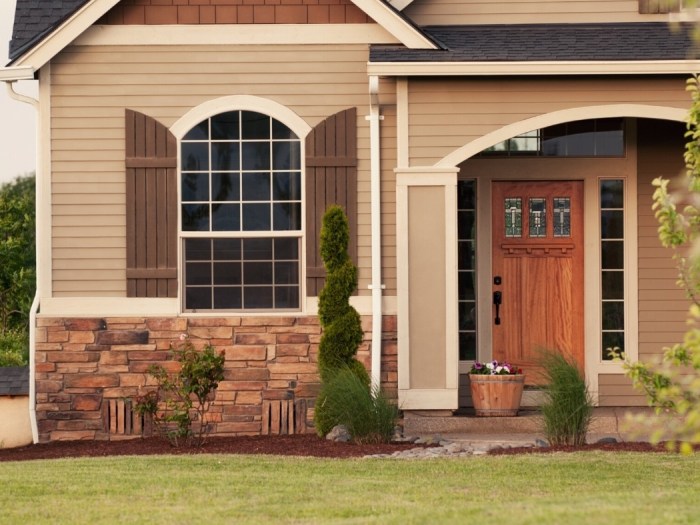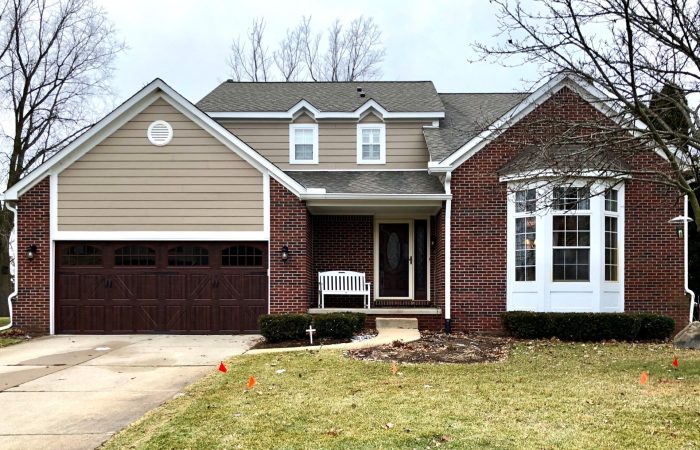The Complete Guide to Residential Exterior Restoration: Enhancing Your Propertys Curb Appeal
Embark on a journey through the Complete Guide to Residential Exterior Restoration, where we explore the key steps and considerations for reviving the beauty of your home's exterior. From planning and preparation to choosing finishes and maintaining your property, this guide covers it all in detail.
Whether you're dealing with peeling paint, damaged siding, or outdated elements, this guide will equip you with the knowledge to transform your property into a stunning masterpiece.
Overview of Residential Exterior Restoration
Maintaining the exterior of a residential property is crucial for not only preserving the structural integrity but also enhancing the overall aesthetic appeal. Regular restoration helps in protecting the property from environmental damage, increasing its longevity, and maintaining a welcoming appearance.
Common Issues Requiring Restoration
- Peeling Paint: Over time, exposure to the elements can cause paint to peel, leading to a worn-out look and leaving the surface vulnerable to further damage.
- Rotting Wood: Moisture can seep into wooden structures, causing rot and compromising the stability of the property.
- Damage to Siding: Harsh weather conditions or physical impact can result in cracks, dents, or breaks in the siding, affecting both the appearance and functionality of the exterior.
Benefits of Regular Restoration
- Enhanced Curb Appeal: A well-maintained exterior creates a positive first impression and adds to the overall attractiveness of the property.
- Increased Property Value: Properties with well-kept exteriors tend to have higher resale value, making restoration a worthwhile investment in the long run.
- Prevention of Further Damage: Addressing issues promptly through restoration can prevent more extensive and costly repairs in the future.
Planning for Restoration
When embarking on a residential exterior restoration project, the initial planning stages are crucial to ensure the success of the endeavor. This involves assessing the current condition of the property, setting a budget, and establishing a timeline for the restoration work.
Assessing Property Condition
Before starting any restoration work, it is essential to thoroughly assess the current condition of the property. This includes examining the exterior walls, roof, windows, doors, and any other structures that may require restoration. Identifying any areas of damage, decay, or wear and tear is key to developing a comprehensive restoration plan.
Setting Budget and Timeline
Once the property condition has been assessed, the next step is to set a budget and timeline for the restoration project. This involves determining the costs involved in materials, labor, permits, and any additional expenses that may arise during the restoration process.
It is important to set a realistic budget and timeline to ensure that the project stays on track and within the allocated resources.
Exterior Surface Preparation
When it comes to residential exterior restoration, proper surface preparation is key to achieving a long-lasting and professional finish. Preparing different exterior surfaces like wood, stucco, or brick is crucial in ensuring the success of the restoration project. This process involves cleaning, sanding, and priming surfaces before applying new finishes.
Wood Surface Preparation
- Clean the wood surface thoroughly to remove dirt, grime, and any old finishes using a mild detergent or wood cleaner.
- Sand the wood surface to smooth out any imperfections, remove old paint or stain, and create a suitable surface for the new finish to adhere to.
- Apply a wood primer to seal the surface, prevent moisture penetration, and improve the adhesion of the final paint or stain.
- Choose sandpaper with the appropriate grit for the task, ranging from coarse for initial sanding to fine for a smooth finish.
Stucco Surface Preparation
- Clean the stucco surface using a pressure washer or a scrub brush and a mixture of water and mild detergent to remove dirt, mold, and efflorescence.
- Repair any cracks or damaged areas with stucco patching compound and allow it to dry completely before proceeding.
- Apply a masonry primer to the stucco surface to promote adhesion and create a uniform surface for the final coat.
- Use a wire brush or sandpaper to smooth rough areas and ensure the surface is ready for painting or coating.
Brick Surface Preparation
- Clean the brick surface with a stiff brush or a pressure washer to remove dirt, debris, and any loose mortar.
- Repair any damaged mortar joints or bricks before proceeding with the restoration process.
- Apply a masonry primer to the brick surface to seal and protect it, enhancing the adhesion of the final paint or coating.
- Choose the right type of primer based on the condition of the bricks and the desired finish, whether it's a paint or a clear sealant.
Repairing and Replacing Exterior Elements
When restoring the exterior of a residential property, it is common to encounter various elements that may require repair or replacement. These elements play a crucial role in the overall aesthetics and functionality of the home, so it is important to address any issues promptly.
Windows
Windows are a key element of any home's exterior and can suffer from issues such as water damage, cracks, or drafts. To address these issues, it is essential to properly seal any gaps or cracks to prevent water infiltration and air leakage.
In cases of severe damage, windows may need to be completely replaced. When replacing windows, it is important to choose a style that matches the existing architectural design of the property to maintain cohesiveness.
Doors
Doors are another exterior element that can deteriorate over time due to exposure to the elements. Common issues with doors include rotting, warping, or damaged hardware. To address these issues, repairs can range from simple fixes like refinishing to more extensive repairs or replacements.
When replacing a door, ensure that the new door complements the architectural style of the home and fits properly to maintain security and energy efficiency.
Trim
Exterior trim, such as fascia boards, soffits, and moldings, can also deteriorate over time due to exposure to the elements. Issues like rot, insect damage, or peeling paint can detract from the curb appeal of the property. Repairing or replacing damaged trim is essential to maintain the structural integrity and aesthetics of the home.
When replacing trim, it is crucial to match the style, material, and color to the existing trim to ensure a cohesive look.
Choosing Exterior Finishes
When it comes to residential exterior restoration, choosing the right finishes can significantly impact the overall look and durability of your property. Whether you opt for paint, stain, or siding, each option has its own set of benefits and considerations to keep in mind.
Different Types of Exterior Finishes
- Paint: A versatile option that comes in a wide range of colors and finishes. It provides excellent protection against the elements but may require more maintenance over time.
- Stain: Ideal for highlighting the natural beauty of wood surfaces, stain is available in various shades and opacity levels. It tends to require less maintenance compared to paint.
- Siding: Popular for its durability and variety of styles, siding options like vinyl, wood, or fiber cement can enhance the aesthetic appeal of your home while providing protection against moisture and pests.
Comparing Durability and Maintenance
- Paint: While paint offers vibrant color options, it may chip or fade over time, requiring periodic touch-ups. Proper surface preparation is crucial for ensuring longevity.
- Stain: Stain penetrates the wood surface, offering protection against moisture and UV rays. It typically requires reapplication every few years to maintain its appearance.
- Siding: Depending on the material, siding can be highly durable and low maintenance. Vinyl siding, for example, is known for its longevity and resistance to rot and pests.
Choosing Colors and Finishes
- Consider the architectural style of your home when selecting colors and finishes. Traditional homes may benefit from classic color palettes, while modern designs can experiment with bold hues.
- Take into account the surroundings of your property, such as landscaping and neighboring homes, to ensure your exterior finishes complement the overall aesthetic of the neighborhood.
- Sample different colors and finishes on a small area of your home to see how they look in natural light before making a final decision. This can help prevent costly mistakes and ensure a cohesive look.
Landscaping and Outdoor Features
Landscaping and outdoor features play a crucial role in enhancing the overall appearance of a residential property. They not only add curb appeal but also create a welcoming and harmonious environment for residents and visitors alike.
Coordinating Landscaping with Restored Exterior
When planning the restoration of the exterior of a property, it is essential to consider how landscaping elements will complement the new look. To achieve a cohesive appearance, choose plants, trees, and hardscaping materials that coordinate with the color scheme and style of the restored exterior.
For example, if the exterior features neutral tones, opt for landscaping elements that enhance rather than clash with the overall aesthetic.
Integrating Outdoor Features
Incorporating outdoor features such as pathways, lighting, and gardens into the restoration plan can further enhance the beauty and functionality of the property. Consider adding a well-lit pathway leading to the entrance or creating a garden area that complements the architectural style of the home.
These features not only add visual interest but also improve the usability of outdoor spaces.
Maintenance and Long-Term Care

Regular maintenance is crucial to preserving the results of your residential exterior restoration work. By implementing a routine maintenance plan, homeowners can ensure that their property's exterior remains in top condition for years to come. This includes ongoing tasks, periodic inspections, and timely repairs to address any issues before they escalate.
Ongoing Maintenance Tasks
- Regularly clean exterior surfaces to remove dirt, debris, and mold buildup.
- Inspect and repair caulking around windows, doors, and other openings to prevent water infiltration.
- Trim trees and bushes to prevent overgrowth that can damage the exterior of the property.
- Check and clean gutters and downspouts to ensure proper drainage and prevent water damage.
Periodic Inspections and Repairs
- Inspect the exterior of the property at least twice a year to identify any signs of damage or wear.
- Address any cracks, peeling paint, or damaged siding promptly to prevent further deterioration.
- Check for signs of water damage, such as stains or rot, and investigate the source of the issue.
- Consider hiring a professional inspector to conduct a comprehensive inspection every few years.
End of Discussion

As we conclude our exploration of the Complete Guide to Residential Exterior Restoration, remember that a well-maintained exterior not only enhances your home's aesthetic appeal but also boosts its overall value. By following the steps Artikeld in this guide, you can ensure that your property remains a source of pride for years to come.
Expert Answers
How often should I conduct exterior maintenance?
Maintaining your property's exterior should be done regularly, ideally at least once a year, to prevent issues from escalating.
Can I tackle exterior restoration projects on my own?
While some minor tasks can be DIY, it's advisable to consult professionals for major restoration projects to ensure quality results.
What are some common signs that indicate the need for exterior restoration?
Signs such as peeling paint, rotting wood, or cracks in siding are indicators that your property may require restoration work.




